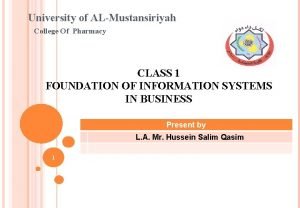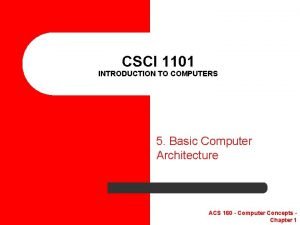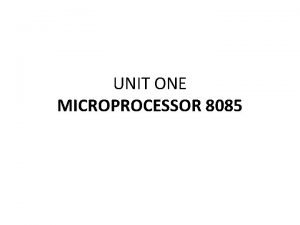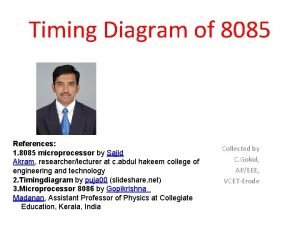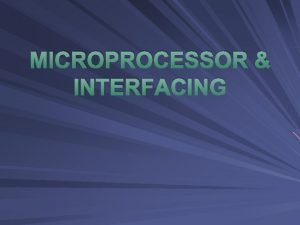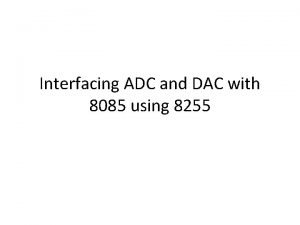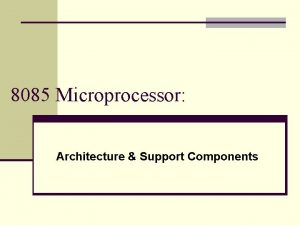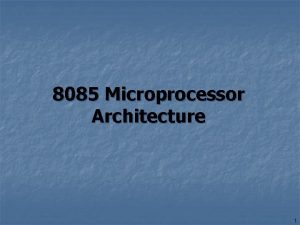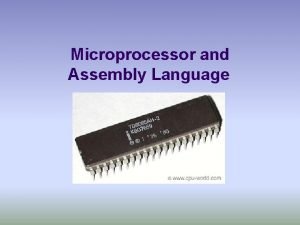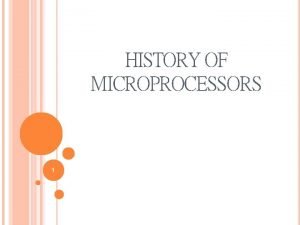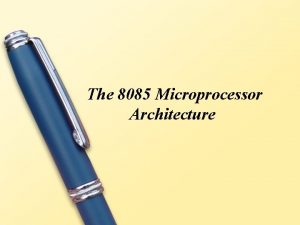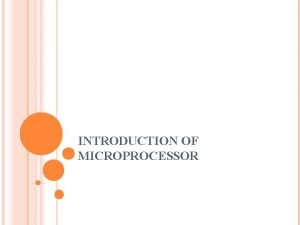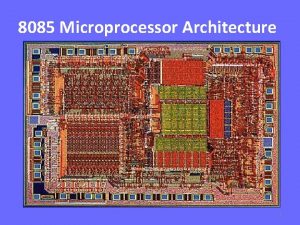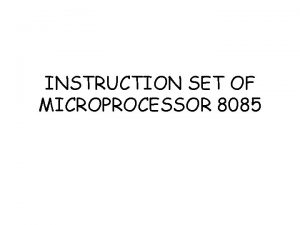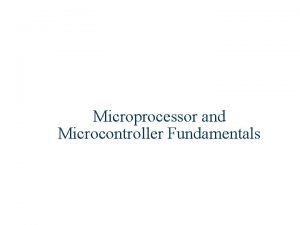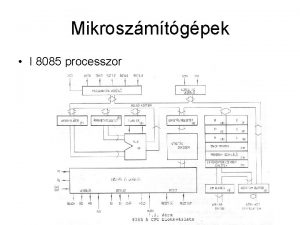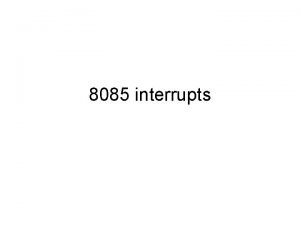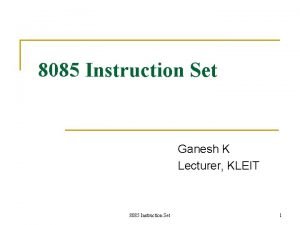MICROPROCESSOR 8085 REFERENCE FUNDAMENTALS OF MICROPROCESSOR AND MICROCOMPUTERS

















- Slides: 17

MICROPROCESSOR (8085) REFERENCE : FUNDAMENTALS OF MICROPROCESSOR AND MICROCOMPUTERS - B. RAM

INTRODUCTION TO 8085 MICROPROCESSOR Ø Microprocessor – central processing unit Ø Heart of the computer Ø 8085 is an 8 bit microprocessor Ø 40 pins Ø +5 vc power supply Ø 80 instructions, 246 opcodes

8085 ARCHITECTURE - BLOCK DIAGRAM

ARCHITECTURE Ø It has 3 main sections Ø ALU – Performs all arithmetic & logical operations Ø Timing & Control Unit – controls entire operations of microprocessor. Ø Registers Ø One 8 bit accumulator or Register A Ø Ø Ø Six 8 bit general purpose registers. B, C, D, E, H & L One 16 bit stack pointer, SP One 16 bit program counter, PC Instruction register Temporary register

ARCHITECTURE Ø Register A holds hold one of the operands of an arithmetic or logical operation. Ø General purpose registers are used to hold 16 bit data by combining two 8 bit registers. Ø These combination is known as register pair. (BC, DE, HL) Ø PC holds the address of the next instruction to be executed. Ø SP holds the address of the top element of data stored in the stack. Ø Instruction register holds the opcode of the instruction. Ø Temporary register holds data during an arithmetic/logical operation

ARCHITECTURE Ø Flags – 5 flip flops serve as flags Ø Carry flag(CS) – It is set to 1, if a carry is produced after an arithmetic operation, otherwise 0. Ø Parity flag(P) – It is set to 1, if the result of an arithmetic/logical operation contains even number of 1 s, otherwise 0 Ø Zero Flag(Z) – set to 1, if the result of an arithmetic/logical operation is 0, otherwise 0. Ø Sign flag(S) – set to 1, if the result is negative, otherwise 0. Ø Auxillary carry flag (AC) – It holds the carry of 3 rd bit to the 4 th bit resulting from the execution of an arithmetic operation.

ARCHITECTURE Ø Program status word(PSW) – Combination of 5 status flags & 3 undefined bits.

PIN CONFIGURATION

PIN CONFIGURATION Ø A 8 – A 15 - Address bus – MSB of memory or 8 bits of I/O address Ø AD 0 -AD 7 - Time multiplexed address/data bus. 8 LSB of memory or I/O address during 1 st clock cycle Data during 2 nd clock cycle. Ø ALE – Address latch Enable Ø IO/M – Whether the address is for memory or I/O Ø S 0, S 1 – status signals 0 0 - HALT 0 1 - WRITE 1 0 - READ 1 1 - FETCH Ø RD - Controls READ operation Ø WR - Controls WRITE operation

PIN CONFIGURATION Ø READY – A peripheral is ready to transfer data. Ø HOLD - Indicates the request of address and data bus by another device Ø HLDA – HOLD Acknowledgement. Indicated hold request has been received. Ø INTR – Interrupt request signal Ø INTA - Interrupt Acknowledgement after INTR is received. Ø RST 5. 5, 6. 5, 7. 5 – Restart Interrupts Ø TRAP – Non Maskable Interrupt Ø PRIORITIES Ø Ø Ø TRAP RST 7. 5 RST 6. 5 RST 5. 5 INTR

PIN CONFIGURATION Ø RESET IN – Resets PC to 0. Ø RESET OUT – Indicates that the CPU is Being reset. Ø X 1, X 2 – Produces a suitable clock for the operation of microprocessor. Ø CLK – Clock output for user Ø SID – Data line for serial input. (RIM Instruction) Ø SOD – Data line for serial output. (SIM Instruction) Ø Vcc - +5 Volts power supply Ø Vss – Ground reference

INSTRUCTION CYCLE Ø Instruction cycle (IC) - Steps taken by CPU to fetch an instruction & necessary data from the memory & to execute it. Ø Instruction Cycle(IC) = Fetch Cycle(FC) + Execute Cycle(EC) Ø FC – CPU fetches opcode from the memory. Ø EC – steps carried out to get data from the memory & to perform the specific operation.

MACHINE CYCLE & STATE

INSTRUCTION & DATA FLOW

TIMING DIAGRAM FLOW OF DATA WORD

TIMING DIAGRAM FOR OPCODE FETCH CYCLE

TIMING DIAGRAM FOR MEMORY READ & WRITE OPERATION
 Microcomputers
Microcomputers Microcomputers
Microcomputers Microcomputers
Microcomputers Basic concepts of microprocessor
Basic concepts of microprocessor Demultiplexing of buses in 8085 microprocessor
Demultiplexing of buses in 8085 microprocessor Timing diagram of 8085 microprocessor
Timing diagram of 8085 microprocessor 4 bit processor
4 bit processor To interface the adc with 8085 we need
To interface the adc with 8085 we need 8085 pins
8085 pins Block diagram of 8085 microprocessor architecture
Block diagram of 8085 microprocessor architecture Assembly language history
Assembly language history Features of 8085 microprocessor
Features of 8085 microprocessor Maskable and non maskable interrupts in 8085
Maskable and non maskable interrupts in 8085 8085 addressing modes
8085 addressing modes 8085 microcontroller architecture
8085 microcontroller architecture Microprocessor block diagram
Microprocessor block diagram Reference node and non reference node
Reference node and non reference node Reference node and non reference node
Reference node and non reference node
